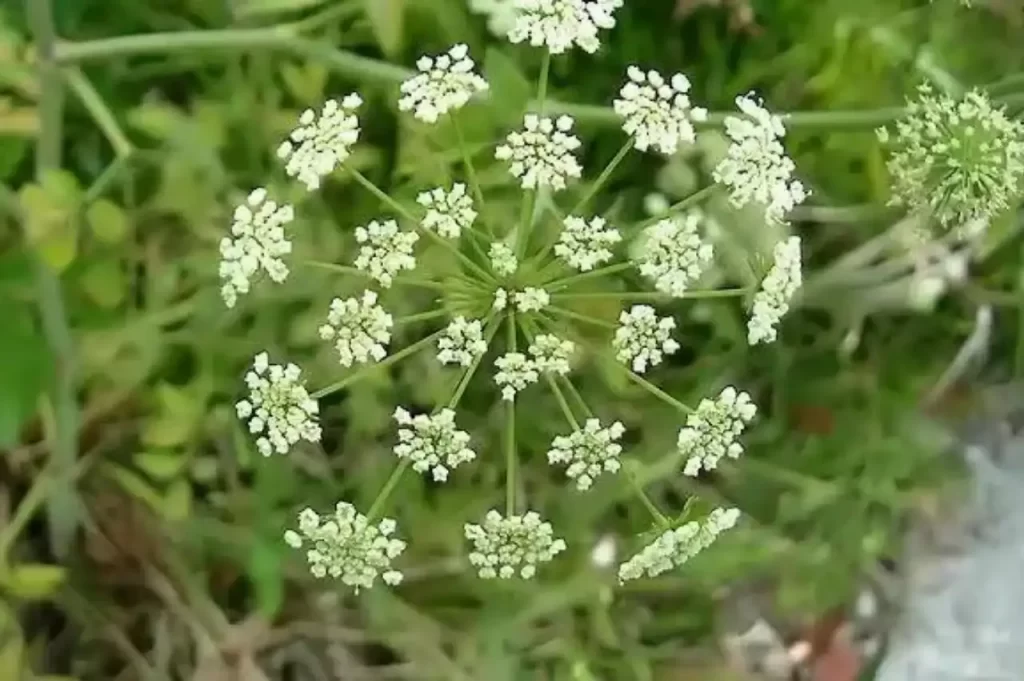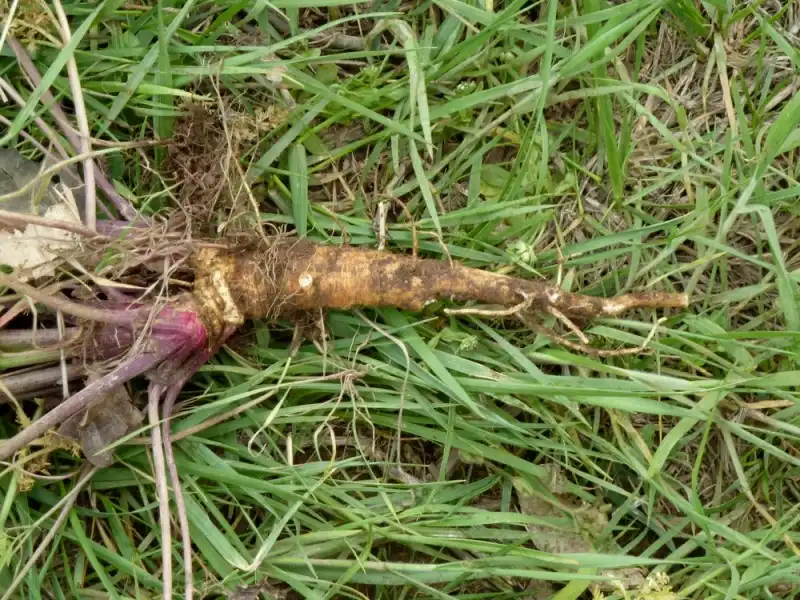
Family Apiaceae includes a special kind of herbaceous and poisonous plant called Poison Hemlock. This is a biennial plant with flowers. It is famous for its rapid spread as a weed. The Scientific name for Poison Hemlock is Conium maculatum.
It is derived from the Greek word ‘Koneois’ which means something that spins or makes a whirling effect. Hemlock is related to the word konas because its ingestion makes the victim dizzy due to its poisonous effect[1]Radulović, N., et al., A novel toxic alkaloid from poison hemlock (Conium maculatum L., Apiaceae): Identification, synthesis, and antinociceptive activity. Food and chemical toxicology, 2012. 50(2): … Continue reading.
Whenever the word Hemlock is under discussion the term poisonous comes readily into our minds. Hemlock describes something suspicious and harmful. This biennial flowering herbaceous plant is notorious for its poisonous seeds and roots.
Conium maculatum was first identified and reported by Swedish botanist Carl Linnaeus in 1753 in his famous publication Species Plantarum.
The other part of its name maculatum means spotted branch or bunch. This also refers to the overall appearance of the plant[2]Panter, K., T. Bunch, and R. Keeler, Maternal and fetal toxicity of poison hemlock (Conium maculatum) in sheep. American journal of veterinary research, 1988. 49(2): p. 281-283.. The term Poison Hemlock cocktail is used for the poisonous drink. This is also known as a poisonous sip or drink. It generally refers to the incident of the death of Socrates.
Ecology of Poison Hemlock (Conium maculatum)
Poison Hemlock is such an herb that can grow on a wide range of soils and its moisture contents. This can tolerate heavy drought without wilting. It regrows very rapidly whenever its favorable environment is back.
Several contents such as Asia, Europe, Africa, Australia, and America have a wide variety of Poison Hemlock in their respective agricultural environments[3]Baskin, J.M. and C.C. Baskin, Seed germination ecology of poison hemlock, Conium maculatum. Canadian Journal of Botany, 1990. 68(9): p. 2018-2024.. It is abundant in Asia and the Mediterranean regions. The other names famous for this plant are ‘deadly hemlock’ and ‘spotted hemlock’[4]Hackney, P. and S.A. Stewart, Stewart & Corry’s flora of the north-east of Ireland. 1992: Institute of Irish Studies, Queen’s University of Belfast..
Read: What’s the most Poisonous Plant in the world?
Rapid Spread and appearance of Poison Hemlock
8 feet is the maximum height achieved by this herbaceous flowering plant. Roots of Hemlock are well indulged into the soil providing the plant with basic nutrients efficiently resulting in its rapid spread. Generally, its stem roots and other parts are bare or exposed without tiny hair-like growth.
Leaves are finely divided into 2 to 4 segments termed pinnate with a typically smooth surface. Its flower has got usually 5 petals. Deep-penetrated roots are responsible for its survival and spread. Its seeds are also carried by the wind. Insects help in pollination.
Hemlock Carrots
Poison Hemlock belongs to the cousin family of carrots and due to former characters, it became quite similar to wild carrot species. The only distinction between Poison Hemlock and Wild Carrots is the smooth surface and especially the long height of the Poison Hemlock plant. Another distinctive property is the hairy plant nature of the Wild Carrot plant is tiny hairs along with the whole plant[5]Nyerges, C., Foraging Arizona: Finding, Identifying, and Preparing Edible Wild Foods in Arizona. 2020: Rowman & Littlefield..
Insect pests of Conium maculatum
It prefers to grow in moist soil. In drought conditions, some arthropod pests may attack Poison Hemlock. Among these arthropods, some species of Lepidoptera and a moth species termed silver-ground carpet moth.
The poisonous fluid feeder of this chemical made by Conium maculatum is called Agonopterix alstroemeriana. The common name for it is Hemlock Moth. This wild moth necessarily eats Poison Hemlock as food. Along with the use of some insecticides, Poison Hemlock can be controlled.
The insect parasites feed on the poison released. As this plant acts as a weed so these moths are now being used as a biological weapon against this weed to limit its growth and promote the growth of actual field crops. This helps in increasing the production of other crops[6]Castells, E. and M.R. Berenbaum, Laboratory rearing of Agonopterix alstroemeriana, the defoliating poison hemlock (Conium maculatum L.) moth, and effects of piperidine alkaloids on preference and … Continue reading.
Roots, Seeds, Flowers of Conium maculatum
With respect to the color of the root of the hemlock plant, it is reddish or purple in color. A person may get easily confused between Conium maculatum and white carrot. Its flowers are also as poisonous as other parts. Intake of flowers can initiate disease symptoms by poisoning of the Hemlock plant. The same is the case with seed ingestion[7]Howell, W. and G. Mink, Viruses isolated from wild carrot and poison hemlock. Plant disease, 1981. 65(3): p. 277-279..

Poison Hemlock Alkaloids
The compound responsible for poisoning is alkaloids. All the plant parts are severely poisonous. Such as the petals have an organic alkaloid called γ-coniceine. Some of the alkaloids act as precursor molecules for other deadly alkaloids. Such as, conhydrine, pseudoconhydrine and gamma-coniceine. Other than being deadly, the same alkaloids have attractive fragrances as well that helm this weed in pollination and spread.
Harmful effects on animals
Animals like sheep, cows, deer, and other herbivores when eating this weed can get infected easily. The digestive tract of animals may get inflamed due to irritation by chemicals known as alkaloids. A certain amount is enough to kill the animals as well.
A smaller amount is enough for transferring the infection to the food chains reaching humans. Improper cooking of meat can also lead to human infections as well. This might be the indirect infection by Poison Hemlock.
Effects of Conium maculatum poisoning
If you ingest even a small segment of the plant it will sharply affect your central nervous system. It will damage your nerves that may lead to paralysis and also death can be the most unwanted consequence. Peripheral vasoconstriction will be faced by the victim leading to disturbance of his or her thermoregulatory center.
The other symptoms have also been observed. These alkaloids stimulate the sympathetic nervous system in rodents which results in increased heart rate. Reports are recorded about the Poison Hemlock that it is also involved in damage or urinary tract[8]Brtalik, D., J. Stopyra, and J. Hannum, Intravenous poison hemlock injection resulting in prolonged respiratory failure and encephalopathy. Journal of Medical Toxicology, 2017. 13(2): p. 180-182..
If there is no immediate treatment provided to the victim acute infection of alkaloid poisoning can cause respiratory paralysis. This means one must need ventilators to be alive which ends in no gain. Because it completely blocks the nerve impulses to the heart and lungs as well which leads to partial paralysis and ultimately death.
Some of the more symptoms of Poison Hemlock are a burning sensation in the digestive tract, severe muscle pain with stiffened areas, and fits or cramps indicating nerve damage. The victim becomes unable to speak properly. It damages the vital organs one by one. Immediate and quick medical attention is necessary for better outcomes which are very less likely to happen.
Big herbivore animals that had been grazing over this weed may get sick. When these infected animals get entry into the human food chain they can be proved to be threatening. i.g. if a pregnant woman accidentally ingests any part of Poison Hemlock it can lead to partial or complete damage to the fetus.
Chronic toxicity can only harm pregnant females. Babies are born malformed[9]Diaz, J.H., Poisoning by herbs and plants: rapid toxidromic classification and diagnosis. Wilderness & environmental medicine, 2016. 27(1): p. 136-152.[10]Bello, O., et al., Wild vegetable Rumex acetosa Linn.: its ethnobotany, pharmacology, and phytochemistry–a review. South African Journal of Botany, 2019. 125: p. 149-160.. Plato and his colleagues described Poison Hemlock as the reason for the death of Socrates in 399 BCE. Some of the history books say that Socrates drank the juice or drink of Poison Hemlock. They named it Hemlock Cocktail.
Uses of Poison Hemlock
A large range of organic chemicals can be obtained from the Poison Hemlock. This is the main reason for its use as a medicinal plant. Several chemical antitoxins are made of this plant against other toxins. Conditions such as Anxiety, Cramps, Swollen Joints, and Mania are treated by its extracts.
Several pulmonary issues such as Asthma, and whooping cough are being cured by its chemicals. Antidotes against other venomous animals are being prepared from it.
Plants to confused with Poison Hemlock
There are several plants that have a close resemblance to Poison Hemlock. First of all wild carrot, fennel, Queen Anne’s lace, and yarrow as well. So whenever you are going foraging keep your garden guidebook with you to avoid misconceptions related to Poison Hemlock. Coltsfoot and Chervil may also get confused with Poison Hemlock.
References
| ↑1 | Radulović, N., et al., A novel toxic alkaloid from poison hemlock (Conium maculatum L., Apiaceae): Identification, synthesis, and antinociceptive activity. Food and chemical toxicology, 2012. 50(2): p. 274-279. |
|---|---|
| ↑2 | Panter, K., T. Bunch, and R. Keeler, Maternal and fetal toxicity of poison hemlock (Conium maculatum) in sheep. American journal of veterinary research, 1988. 49(2): p. 281-283. |
| ↑3 | Baskin, J.M. and C.C. Baskin, Seed germination ecology of poison hemlock, Conium maculatum. Canadian Journal of Botany, 1990. 68(9): p. 2018-2024. |
| ↑4 | Hackney, P. and S.A. Stewart, Stewart & Corry’s flora of the north-east of Ireland. 1992: Institute of Irish Studies, Queen’s University of Belfast. |
| ↑5 | Nyerges, C., Foraging Arizona: Finding, Identifying, and Preparing Edible Wild Foods in Arizona. 2020: Rowman & Littlefield. |
| ↑6 | Castells, E. and M.R. Berenbaum, Laboratory rearing of Agonopterix alstroemeriana, the defoliating poison hemlock (Conium maculatum L.) moth, and effects of piperidine alkaloids on preference and performance. Environmental entomology, 2006. 35(3): p. 607-615. |
| ↑7 | Howell, W. and G. Mink, Viruses isolated from wild carrot and poison hemlock. Plant disease, 1981. 65(3): p. 277-279. |
| ↑8 | Brtalik, D., J. Stopyra, and J. Hannum, Intravenous poison hemlock injection resulting in prolonged respiratory failure and encephalopathy. Journal of Medical Toxicology, 2017. 13(2): p. 180-182. |
| ↑9 | Diaz, J.H., Poisoning by herbs and plants: rapid toxidromic classification and diagnosis. Wilderness & environmental medicine, 2016. 27(1): p. 136-152. |
| ↑10 | Bello, O., et al., Wild vegetable Rumex acetosa Linn.: its ethnobotany, pharmacology, and phytochemistry–a review. South African Journal of Botany, 2019. 125: p. 149-160. |



